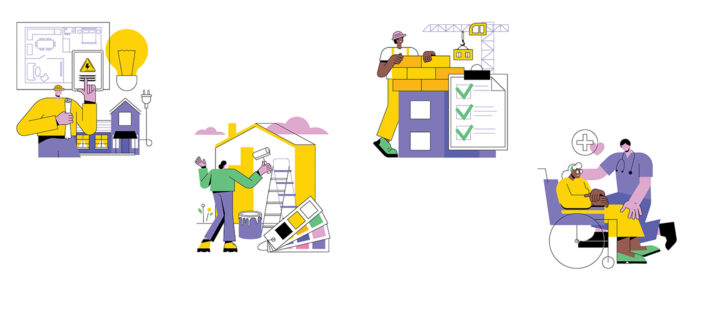There was a time when people aspired to make a living in a skilled trade. Plumbers, electricians, carpenters and others provided for their families successfully and looked forward to training their successors. Today, the skilled trades are a forgotten art practiced by an older generation now shifting out of the workforce without anyone to “hand the wrench” to before they leave. The shortage of skilled trade workers is becoming a significant problem as it is estimated that for every three who retire, only one takes their place. Over a million skilled trade positions in the United States remain vacant despite high unemployment and the shortage is beginning to affect the government (building projects, road work, etc.) and consumers. For example, it is not uncommon to have to wait nearly six months to get a new roof installed or begin building a house. Skilled trades will always be needed by society and civilization. So, what happened? Where are all the tradesmen and tradeswomen?
Defined as an occupation that requires a particular skill set, knowledge, or ability, examples of today’s skilled trade professions include: carpenter, electrician, plumber, mason, farmer, painter, train operator, aircraft maintenance, licensed practical nurse (LPN), respiratory therapist, landscaper, chef, welder and machinist, among others. Most experts pinpoint the decline of skilled trade professionals to take place during the early 2000s and cite four reasons why.
- Elimination of skilled trades from high school curricula – shop classes, electronics and more have been cut.
- The Great Recession (2007-2009) put many trade companies out of business with none taking their place.
- Social pressure and the “college-or-bust” belief of Gen X, Millennials and their parents – many falsely believed that those without a college degree were “lesser” individuals. Children of the ‘80s or ‘90s believed that they MUST go to college without any other viable alternative being presented to them.
- Baby Boomers began to retire (with more to come). The average age of persons working in skilled trades today is 55. When they leave, will there be anyone left to do those jobs?
The young adults graduating from high school today can easily fill these roles. It is important to let the younger generations know that there are alternatives to the standard four-year college experience that can lead to a successful life. In fact, learning a trade triumphs over the traditional college route in five respects:
- Skilled trade jobs are in high demand – it is estimated that nearly 75% of trade school graduates end up doing the exact job related to their degree or certificate.
- Better job security –The majority of trade jobs are represented by a union and today’s scarcity of workers can lead to numerous opportunities for a single individual.
- It’s more affordable – A four-year college degree can range from $40,000 to $100,000 in loans and fees. Learning a trade can cost half, a quarter of that or less, with some professionals completing their training with no debt at all.
- It takes less time – The average amount of time to reach the journeyman level is two years (depending on specific trade). During that time, the student is already making money and gaining real world experience.
- Salaries are comparable to most with traditional college degrees – skilled tradesmen earn average annual salaries of $60,000. Today’s most in-demand skilled trades are: HVAC technician, plumber, construction manager, rotary drill operator, boilermaker, electrician, home inspector, wind turbine technician, aircraft mechanic and lineman.
This process involves the same decisions as one would make in choosing a college or major course of study.
Step 1: Complete high school or equivalent (GED).
Step 2: Choose a trade.
Step 3: Find and select an education program.
Step 4: Obtain and complete Apprenticeship (approx. 2 years).
Step 5: Get licensed.
Step 6: Become a journeyman.
Step 7: Continue education/become a Master.
In Michigan and Genesee County, the process is the same.
Example:
Janet loves to work with her hands, has helped her father with rewiring their home and she enjoyed it. In the next year she will graduate from Flint Southwestern High and is deciding what career to pursue. She considered college and although she earned great grades, didn’t feel drawn to any one subject. Besides, she didn’t want to wait four years to start earning her own way and the potential debt really worried her. Her friend’s father worked as an electrician and seemed to afford a nice house, car and more. Janet decided that after graduation, she would become an electrician.
Janet looked into various avenues of study and saw that Mott Community College offered a degree in Electronics and Electrical Technology that she could take while working as an apprentice or she could apply for the program offered by Flint/Saginaw Electrical Joint Apprentice and Training Committee. After enrollment in the school of her choice, Janet must register with the state as an apprentice. Over the next few years of apprenticeship, she will work and be paid while attending school until she completes 576 hours of classwork and over 8,000 hours of supervised electrical work, at which time she can take the exam to become a licensed journeyman and begin earning a higher wage. After two years as a journeyman and at least 12,000 hours of electrical work, she can apply for a master electrician license. If she gets that, she can begin training apprentices of her own. In about six years after high school graduation, Janet can be making almost $86,000 a year working as an electrician in the State of Michigan.
College is not the only road to professional success. More than ever, the United States is in dire need of skilled trades workers. These valued workforce members also have the opportunity to become entrepreneurs by starting their own business. For job security, job availability and a good union wage, a profession in the skilled trades is a solid choice … and nothing to be looked down upon! Skilled trades built this country and are a fundamental part of it. For a career and earning potential that will last to retirement, consider mastering a skilled trade.








